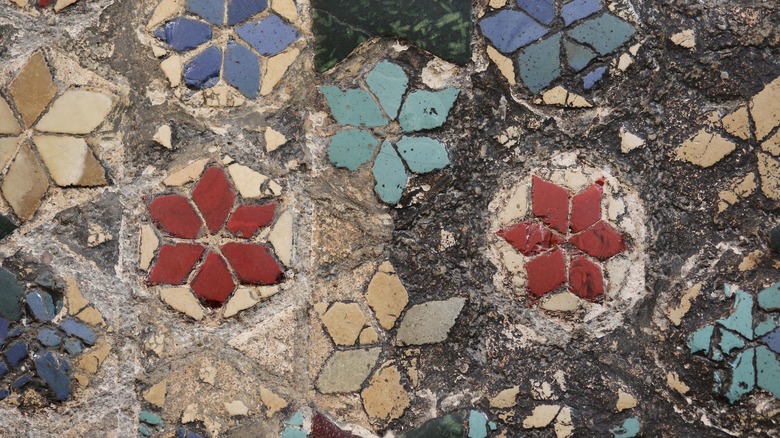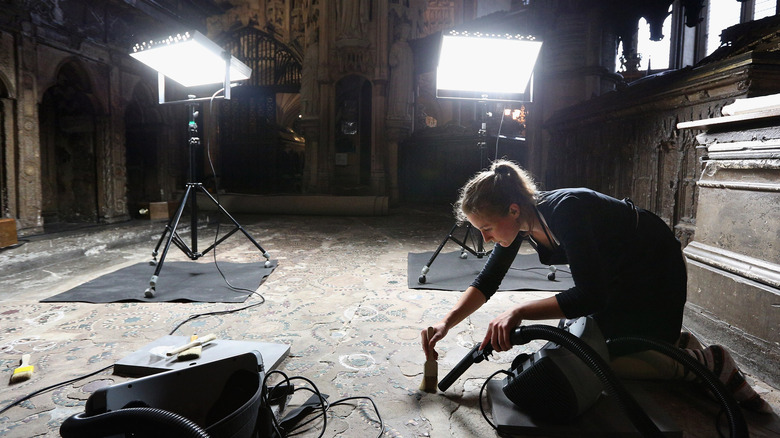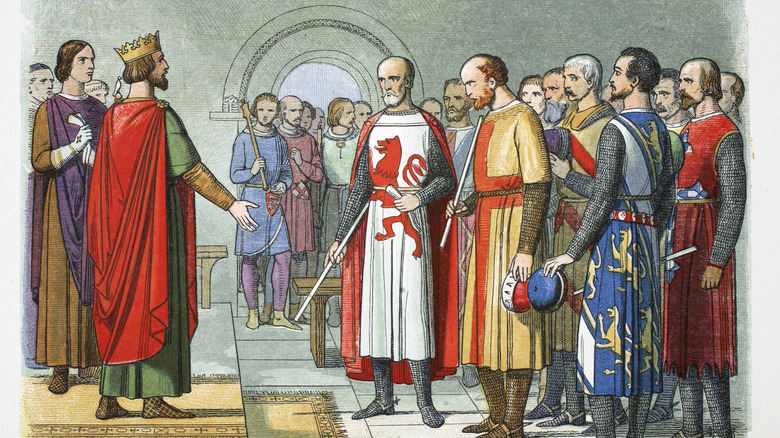The History Of Westminster Abbey's Cosmati Pavement
Covered with thick carpet for the past 150 years, a priceless treasure of Westminster Abbey has remained unseen as a way of preservation (via The Guardian). Over the centuries, this piece of art and architecture from medieval times was trodden upon by kings, queens, bishops, and cardinals. Few modern visitors have seen this Italian decorative stonework, the only example of its kind north of the Alps.
The Cosmatesque pavement method was popular in Rome in the 12th and 13th centuries (via "Westminster Abbey: the stones of the Sanctuary Pavement"). It's named after a family of Italian marble workers. Four generations of the Cosmati were decorative stone masons and masters of this mosaic pavement method. Though studied for ages, there are certainly intentions of these designs that are lost to time. For the 13th century, its installation in England represents a great achievement in international communication, logistics, and transport.
The geometric design represents a mix of numeric symmetry and ratios. Most of the stones are original, though the durability of each type has become obvious with time. Others were lost to pilgrims taking souvenirs over the centuries, and ancient transcriptions experienced repeated condensation and can no longer be deciphered. Of course, the stones installed at Westminster Abbey were placed for more than a show of wealth — they carry great symbolism, as well as political and historical significance.
What composes the Cosmati tiles of Westminster?
At every level of inspection, the Cosmati craftsmen's opus sectile (or "cut work") tiling is impressive. Set in Purbeck marble, stones were brought in from disparate regions of Europe (via Nexus Network Journal). Some from Italy, others from France, the design features stones such as Egyptian gabbro, Tadcaster limestone, alabaster, and white and pink breccia corallina marble (via "Westminster Abbey; the stones of the Sanctuary Pavement"). The porphyry rock sparkles with embedded crystals and brings green and purple colors to the mosaic's pallet. Added to the detail are opaque and transparent potassium-lime glass from northwestern Europe, most likely France.
These tiles are cut into shapes that differ from the more common cubes popular at the time in England. The geometric elements of the pavement include numerous quincunx. Like how the dots are arranged on the five-side of a die, quincunx features individual objects placed in four corners and a fifth in the center. To fully appreciate the scope of the installation, the best view of the pavement is from the triforium — a gallery above the arches of the choir. Only from there can you see that the design is truly quincunxes within a quincunx, a frame of roundel figure eights, and observe the final outline of tombs.
Henry III commissions the mosaic
Called the "Great Pavement," the Italian stonework dates back to A.D. 1268, according to an article in the Nexus Network Journal. Its installation was commissioned by Henry III. His reign featured the continuation of strife between the monarchy and powerful Barons. For significant parts of his rule, the article says Henry III was "subject to the authority of the Baronial Council."
Henry III was often preoccupied with his salvation. He identified and relied on his perceived support from the 11th century's St. Edward the Confessor. Henry believed this saint guided him in life and would lead him to the next. It became Henry's goal to enshrine St. Edward in Westminster Abbey. Wanting something truly special, he commissioned workmen all the way from the Mediterranean. This decision was made in spite of Henry having never been to Italy or seen Cosmati pavement.
It proved difficult to fund the work Henry III hoped would align him with St. Edward. He was determined to live to see the carefully selected day of the shrine's translation in 1269. The day of the translation featured political drama. According to the piece in Nexus Network Journal, a "[quarrel] broke out during the ceremony and the bishops did not form a procession behind the body of Edward the Confessor." Eventually, Edward the confessor was enshrined in a tomb located behind the High Alter and surrounded by unique and priceless tilework commissioned by an ardent believer (via "Westminster Abbey: the stones of the Sanctuary Pavement").


